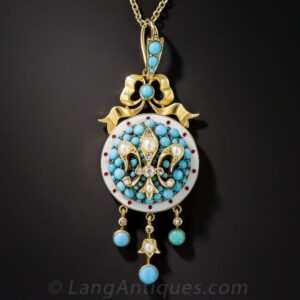
Turquoise is chemically a hydrous copper aluminum silicate, occurring in microcrystalline nodules. It has been coveted and admired throughout our history because of its magnificent color.
Turquoise is porous and relatively soft. Its porosity makes it susceptible to discoloration by the absorption of oils and pigments. That is why today, most turquoise has been color stabilized, or treated with wax, plastic resins, or sodium silicate in an attempt to solve that problem. Often dye is added to the substances used for stabilization.
Turquoise crystallizes in veins and nodules near the water table in arid environments.
A Brief History of Turquoise
Turquoise has the oldest documented history of all gems. The first use of turquoise was in Mesopotamia. Beads dating back 5,000 years have been found. Turquoise was the first gem mineral to be mined by man. It was also the first to be imitated! Turquoise beads, in Egypt, have been found dating back to 4000 BC.
Surviving records from the First Dynasty in Egypt, document extensive mining operations for turquoise on the Sinai Peninsula. These mines employed thousands of laborers and continued in operation until 1000 BC. Curiously, in 3100 BC, perhaps because supply was not meeting demand or cheaper products became necessary, imitation turquoise was used in some ornamentation. The first imitations used were dyed varieties of softer soapstone.
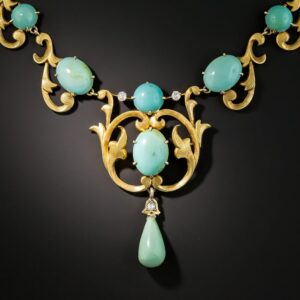
Turquoise is a blue, blue-green or grey-green opaque gemstone whose name is derived from the Turkish trade route along which these stones traveled to reach Europe in ancient times. It is almost always cut en cabochon, although sometimes it is seen in nugget form or even faceted. It has a waxy luster and is able to achieve a high polish. Limonite is the host rock for turquoise and it shows occasional spots or veins of limonite patterning. The main historical sources were the Nishapur region of Persia (currently Iran) and the Sinai Peninsula. Popular since ancient times, turquoise deposits in the Sinai were already depleted by 4,000 BC. Turquoise was, and is, valued for jewelry and other adornments, including cosmetics.
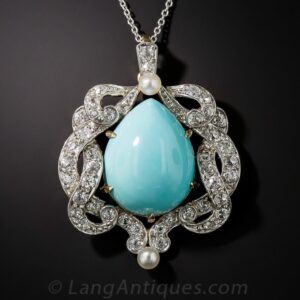
Throughout history, turquoise has been prized for its perceived talismanic properties. Ancient Egyptians were known to carve it into animal figures that were worn as symbols of their gods. During the Middle Ages turquoise was valued for its supposed ability to prevent falls from horseback and protect the wearer from poisons. In the seventeenth century, the gem was worn almost exclusively by men and it was considered a necessity for well-dressed gentlemen to be wearing fine turquoise. Persians have appreciated turquoise as beautiful and powerful down through the ages with a saying that
…. to escape evil and attain good fortune one must see the reflection of the new moon either on the face of a friend, on a copy of the Koran, or on a turquoise…1
This ranks turquoise on a level with religion and friendship, a very powerful stone indeed.
Native Americans greatly valued the gem. Zuñis held it sacred, carving fetishes and talismans in the forms of animals, insects, and other living shapes. Navajo legends speak of turquoise jewel baskets. The Apaches also held turquoise in high regard and Apache medicine men and shaman regarded turquoise as an absolutely essential material. Following a rainbow resulted not in a pot of gold but of turquoise and it was thought beneficial in aiding the accuracy of a hunter’s aim, a power highly valued by the Apache.
The use of turquoise by Native Americans began about 1000 years ago. It was found in Mount Chalchihuitl in New Mexico. Using hand tools, the entire mountain was quarried. All that remains today is a pit measuring 200 feet across and 130 feet deep.
Queen Victoria’s love of turquoise was no secret. It is said that upon her marriage to Albert, Queen Victoria gave portrait rings to her ladies-in-waiting. Each miniature portrait of the Queen was surrounded by turquoise cabochons. Tiny turquoise cabochons were also commonly pave set in mid-Victorian jewelry covering snake motif bracelets and necklaces, brooches and the like. Turquoise enjoyed a resurgence in the late Victorian era and was set in rings, brooches, and earrings but in larger sizes than in earlier periods. In the Twentieth Century, turquoise enjoyed great popularity with \the Native American jewelry revival that spanned the 1950s through the 1970s.
The porous nature of turquoise invites dying and impregnation with waxes and polymers. Powdered turquoise is often reconstituted, along with other ingredients, and sold as gem turquoise. Dyed howlite, dyed chalcedony, glass, ceramics, plastic and many other materials have been used to simulate turquoise.
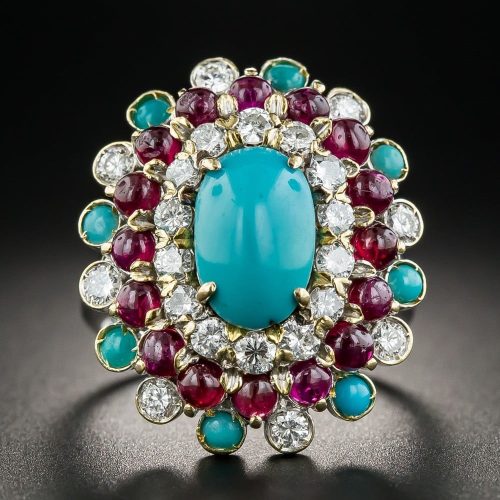
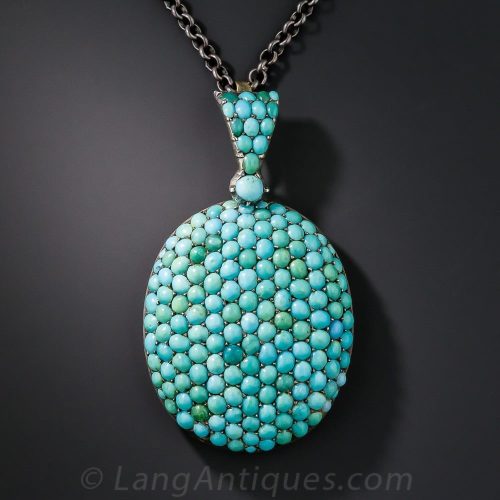
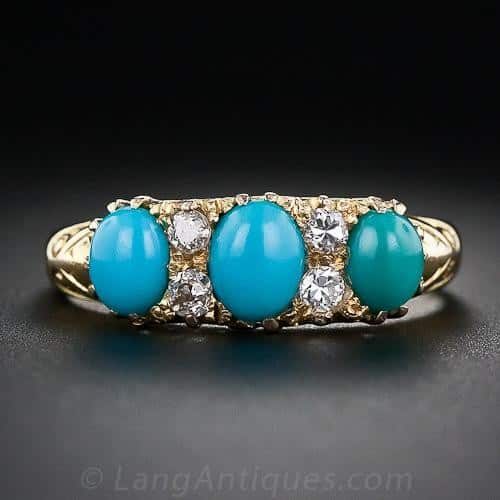
Gemological Information for Turquoise
| Color: | Various Shades of Blue and Green |
| Crystal Structure: | Triclinic |
| Refractive Index: | ~1.62 |
| Durability: | Average to poor |
| Hardness: | 5-6 |
| Family: | |
| Similar Stones: | Dyed Howlite, Amazonite, Plastic, Serpentine |
| Treatments: | Dyeing, Coatings |
| Country of Origin: | Iran, Afghanistan |
Turquoise Care
| Ultrasonic Cleaning: | Not Safe |
| Steam Cleaning: | Not Safe |
| Warm Soapy Water: | Safe |
| Chemical Attack: | Avoid |
| Light Sensitivity: | Stable Unless Dyed |
| Heat Sensitivity: | Not Stable |
Sources
- Campbell, Marian. Medieval Jewellery. London: V & A Publishing, 2009. P.28.
- Gem Reference Guide, Los Angeles: Gemological Institute of America, 1988. Pp. 252-255.
- Kunz, George Frederick. The Curious Lore of Precious Stones, New York: Bell Publishing Company, 1989. Pp. 108-114.
- Newman, Harold. An Illustrated Dictionary of Jewelry, London: Thames and Hudson, Ltd., 1981. P.314.
- Romero, Christie. Warman’s Jewelry, Radnor, Pennsylvania: Wallace-Homestead Book Company, 1995. P. 60.
- Schumann, Walter. Gemstones of the World, New York: Sterling Publishing, Co., 1977. P.170.
Notes
- Kunz, p.111.↵